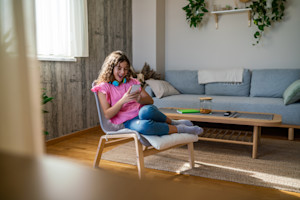
Cyberbullying
Protecting your teen from the "BM Boys" and sextortion
Learn prevention strategies to protect your family from sophisticated sextortion scams.
Read article
Nimmi Kanji
Director - Social Purpose Programs, For Good and TELUS Wise

How are youth spending time online, and what types of digital experiences are young people having? In her research on youth well-being, Dr. Johanna Sam, Michael Smith Health Research BC Scholar and Assistant Professor in the University of British Columbia’s Faculty of Education in the Department of Educational and Counselling Psychology, and Special Education as well as NITEP - Indigenous Teacher Education Program, aims to answer that question through the voices and words of young people themselves.
To gain insight into the practical applications of Dr. Sam’s work, we had an in-depth discussion with her about what inspired her, her research methods and approaches, the importance of resilience for youth and advice for parents.
Q: Can you tell us about your background, the focus of your research and what inspired you to pursue that path? JS: I am a citizen of the Tŝilhqot’in Nation. I currently live and work on the traditional lands of the Musqueam People known as Vancouver, British Columbia. In my research at UBC, I focus on youth well-being and how they are spending time online. It is my goal to elevate diverse youth voices and understand their experiences in their own words. When I first started asking youth about their online lives, their answers surprised me. They told me, “there is no difference between online and offline, it’s just life.” The online experience is completely integrated into what they do every day.
In my work, we use traditional research approaches like surveys but we also try to capture youth voices in different ways as well. Our collective storytelling project brings together a small group of five to 10 youth in a sharing circle. The participants create a story about a typical youth, and we explore what the main character of the story does online, if/how people are being mean to them, how they respond and how they think, feel and behave. Using a character, youth can draw on their own real-life experiences and share them in a safe way, without guilt or shame.
Q: Talk about your work at C.I.R.C.L.E at UBC. What are you learning about cyberbullying and its impacts? JS: C.I.R.C.L.E is the research lab I run at UBC that includes undergrad to graduate students and Indigenous community members. We focus on digital storytelling in Indigenous communities, youth cyberbullying and cultural differences, climate change and youth well-being. We look at things through a cultural lens and focus on diversity, inclusivity and equity amongst youth.
Our team had an interesting experience with a group of youth during the pandemic. We were using social media to recruit youth to participate in a sharing circle, offering a $50 honorarium. A group of teens - perhaps in an attempt to cause trouble or act out - sent hundreds of responses to our ads without the intention of attending. I reached out and invited them to participate. Ten of them, all of whom identified as visible minorities, attended. During the sharing circle, they created a story about a young man named Peter who created videos online and experienced online hate based on his ethnicity. They also shared that Peter dealt with this experience by talking to family and turning to trusted social media influencers. We were able to transform a negative experience into a positive one by giving these youth their first opportunity to share their voices in this way, in a safe, non-judgemental environment.
Q: What are the similarities and differences between how Indigenous and non-Indigenous youth cope with cyber aggression? JS: There are only slight differences. All youth talk to peers first about what’s happening online. They will then turn to trusted adults if they need an extra level of support. Indigenous youth will seek out other Indigenous influencers, advocates and entrepreneurs online. They want to see themselves represented. And both Indigenous and black youth rely on their large extended family networks for support. When we ask about the nature of cyber aggression they experience, a lot of them talk about online hate and attacks on their Indigenous identity based on stereotypical views of Indigenous people. In terms of coping, taking time away from the device helps. A young person in one of our sharing circles imparted advice from one of his trusted adults who told him to, “go touch the grass.” Get off the device for a while, go outside and have a chance to reset.
Q: The two-eyed seeing approach is integral to your work. Can you explain what that is and how it applies to youth and cyberbullying? JS: We bring together Indigenous and non-Indigenous ways of knowing to uphold diverse youth and diverse voices. Much of the time, cyberbullying research is done in classrooms with middle-class kids using surveys. But reaching a diverse community is so vital. We meet youth where they are online to get them involved. Storytelling is a relatively new approach to cyberbullying research. In our sharing circles, we create stories together to capture youth’s voices and experiences in their own words.
Q: How can we support youth who experience challenges online? JS: Resilience is the strength to overcome hardship or bounce back from a difficult time. Youth are going to have difficult experiences online. How do we support them, so they don’t internalize the experience and feel like it weighed them down? We talk a lot about being a warrior and building strength – whether that means finding role models online that look like them or sharing with trusted adults. Youth don’t really relate to jargon and typical terms like “coping.” We constantly modify and adapt our research into language that makes sense to youth. We have to meet youth where they are and connect with them in a way that makes sense to them.
Q: What advice do you have for parents, educators and youth based on your work and research? JS: Devices are part of our daily lives, especially for youth. Start having conversations with youth as soon as they start engaging with devices. Parents are really concerned about screen time, and I get asked about it a lot. I advise parents to find ways to help youth self-regulate their own device use. Get curious about what they are doing online. For example, if your child is gaming, ask how long they think it will take to get to that next level or goal. Then negotiate that time with them and offer some alternatives for things they could be doing with that time. It’s also important to understand that much of youth’s activity online has a social component to it. While they may be playing a game, it could be the only time they get to virtually hang out with certain friends, which can have a positive impact on their well-being.
Q: Any final thoughts? JS: Youth voices matter. It’s vital to meet them where they are and talk with them. Most youth are willing to share their experiences if we ask in a way that makes sense to them. They come up with great solutions that help others as well. My work is all about making space for and uplifting diverse youth voices. Creating safe spaces for youth to share their experiences helps to inform our advocacy, which is so critical for youth well-being in a digital world.
To learn more, explore cyberbullying resources and participate in the Supporting youth in our digital world online workshop.

Learn prevention strategies to protect your family from sophisticated sextortion scams.
Read article
Discover practical tips for adults to help youth build positive online habits year-round.
Read article